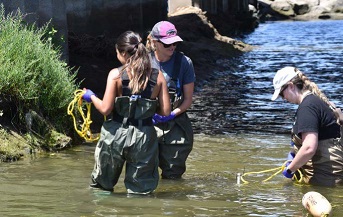Scientific foundation established to question California shellfish water-quality objective

SCCWRP and its partners have completed a study that calls into question the appropriateness of a bacterial water-quality numeric objective designed to protect the health of people who consume shellfish from Newport Bay in Orange County.
During the two-year study, which was completed in the spring, researchers found that bacterial and pathogen levels in Newport Bay do not correlate with potentially unsafe levels of viral pathogens found in bivalve shellfish harvested from the bay. The existing water-quality objective for recreational shellfish – abbreviated SHEL – is intended to protect recreational shellfish harvesters by limiting bacterial levels in coastal waters where shellfish can grow.
Based on the findings of the study – which was conducted during the dry summer months – researchers have begun planning for a second phase, which involves largely repeating the study during wet weather. Newport Bay bacterial levels tend to be higher during wet weather as stormwater runoff flows through the bay to the coastal ocean.
The outcomes of the back-to-back studies are expected to help inform decision-making about a looming regulatory compliance deadline regarding Newport Bay’s SHEL objective. Under Newport Bay’s fecal coliform TMDL (total maximum daily load), the watershed’s stormwater discharge permittees face a December 2022 deadline to meet the SHEL objective. Newport Bay, which will be the first water body in California to reach an enforceable compliance deadline for SHEL, fails to meet the objective year-round at certain locations in the Bay.
The Santa Ana Regional Water Quality Control Board is among the regulatory agencies that have questioned whether the commercial shellfish sanitary standard – set nearly a century ago and not validated using local shellfish data – is supported by a sufficient technical foundation. The State Water Resources Control Board, meanwhile, has identified the SHEL standard as a strategic priority to address.
To protect consumers of recreationally harvested shellfish in Newport Bay and elsewhere, California presently uses the numeric food safety standard as the ambient water quality objective.
The SHEL water quality objective is significantly more difficult to achieve than California’s bacterial water-quality objective designed to protect the health of beachgoers, known as the REC-1 objective. The REC-1 objective caps monthly median fecal coliform counts in the water column – a proxy for potential pathogenic contamination – at 200 MPN/CFU per 100 mL, among other measures.
By contrast, the SHEL objective caps monthly median fecal coliform counts at 14 MPN per 100 mL.
Newport Bay recreational beaches are largely in compliance with REC-1 water-quality objectives during the popular summer beachgoing months, although they often exceed REC-1 objectives during wet weather.
During the Newport Bay study’s first phase, oysters were placed in cages in Newport Bay, then harvested at different time points over a six-week period. Researchers measured viral pathogens and fecal bacterial indicators in the oysters’ tissue, as well as simultaneously collected water samples to quantify contaminants that the filter feeders would have been exposed to.
The findings of the dry-weather study will be published in a forthcoming technical report and journal manuscript. The wet-weather work is expected to be launched in winter 2022-2023.
For more information, contact Dr. Amy Zimmer-Faust.
More news related to: Microbial Risk Assessment, Microbial Water Quality, Top News